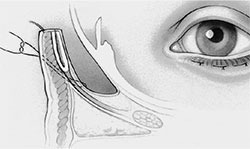Letters
Thoughts From Your Colleagues
Download PDF
Quickert Suturing for Involutional Entropion
I write in response to “Diagnosis and Management of Involutional Entropion” (Ophthalmic Pearls, February). I’m retired now, but, in 39 years of practice, I have had many occasions to appreciate the ease and simplicity of the Quickert suturing method after Marvin Quickert published it fairly early in my career.
Success does indeed depend on how well you can capture the lower lid retractors on the downstroke of the suture. It also depends on the lateral laxity of the lid not being too great. If the latter is contributing to the problem, lateral canthal lid tightening does greatly increase the chances of a lasting correction. In some patients, horizontal lid laxity is due in part to an almost total loss of medial canthal anchoring of the tarsus, which makes horizontal lid tightening a bit more complicated!
 The great advantage of simple Quickert suturing is that it can be done fairly easily in severely ill and debilitated patients who are difficult or nearly impossible to relocate for a more extensive procedure. Over the years, I have accomplished many of these procedures at the bedside in nursing homes. Many of those patients achieved immediate relief of their eye discomfort, and, often, late recurrences were not a consideration because of the natural course of their other illnesses.
The great advantage of simple Quickert suturing is that it can be done fairly easily in severely ill and debilitated patients who are difficult or nearly impossible to relocate for a more extensive procedure. Over the years, I have accomplished many of these procedures at the bedside in nursing homes. Many of those patients achieved immediate relief of their eye discomfort, and, often, late recurrences were not a consideration because of the natural course of their other illnesses.
Quickert suturing is a quick, expedient remedy with a significant late recurrence rate. Its major advantage is that it can achieve prompt relief of an acute problem with corneal erosion very quickly and with minimal disturbance, even in a bedridden patient.
The technique was actually published by Quickert & Rathburn in 1971,1 while I was still a resident. Sadly, Marvin Quickert met an untimely death in 1974, which was my first year in practice, but I found his method for entropion to be a handy tool from my earliest years in practice. A number of papers and reviews published since then have suggested improvements to the technique, many of which are quite useful. But the simplicity of the basic approach is its major appeal.
William J. Prendergast, MD
Portland, Ore.
___________________________
1 Quickert MH, Rathbun E. Arch Ophthalmol. 1971;85(3):304-305.
| WRITE TO US Send your letters of 150 words or fewer to us at EyeNet Magazine, AAO, 655 Beach Street, San Francisco, CA 94109; e-mail eyenet@aao.org; or fax 415-561-8575. (EyeNet reserves the right to edit letters.) |